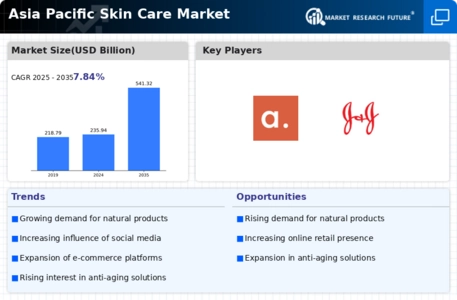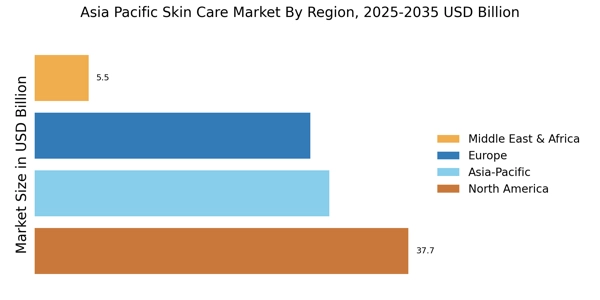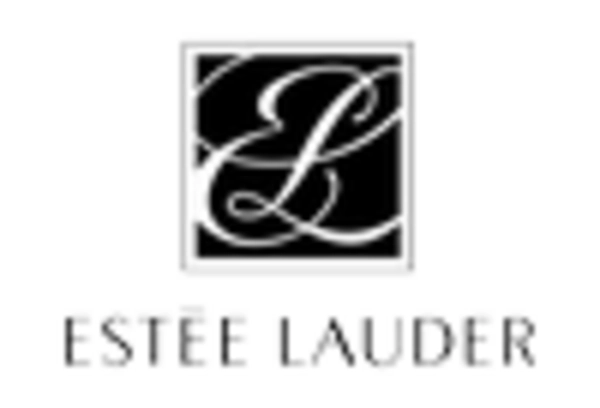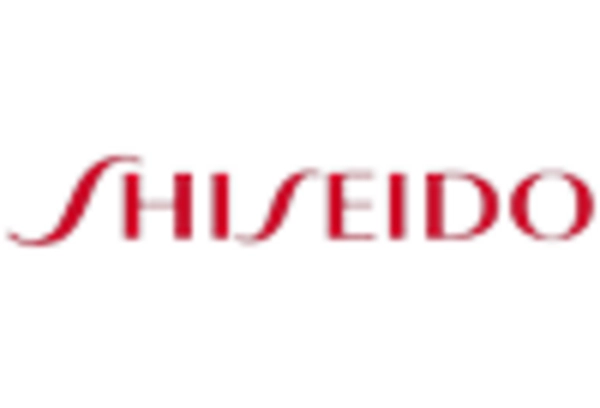Increasing Consumer Awareness
The Asia Pacific Skin Care Market is witnessing a notable surge in consumer awareness regarding skin health and the benefits of skincare products. This heightened awareness is largely driven by the proliferation of information through digital platforms and social media. Consumers are increasingly educated about the ingredients in their skincare products, leading to a demand for transparency and efficacy. As a result, brands are compelled to provide detailed information about their formulations, which has led to a rise in the popularity of products that are clinically tested and dermatologically approved. This trend is reflected in the market data, indicating that the demand for premium skincare products has increased by approximately 15% in the last year alone, suggesting a shift towards quality over quantity in consumer purchasing behavior.
Growth of E-commerce Platforms
The Asia Pacific Skin Care Market is experiencing a significant transformation due to the rapid growth of e-commerce platforms. With the increasing penetration of the internet and mobile devices, consumers are increasingly turning to online shopping for their skincare needs. This shift is not merely a trend; it appears to be a fundamental change in consumer behavior. E-commerce sales in the skincare sector have reportedly grown by over 20% in the past year, indicating a robust preference for the convenience and variety that online shopping offers. Additionally, brands are leveraging digital marketing strategies to reach a broader audience, enhancing their visibility and accessibility. This evolution in retail channels is likely to continue shaping the market landscape, as more consumers embrace the ease of purchasing skincare products online.
Rising Demand for Anti-Aging Products
The Asia Pacific Skin Care Market is currently witnessing a rising demand for anti-aging products, driven by an aging population and increasing awareness of skincare among younger demographics. As individuals become more conscious of maintaining youthful skin, the market for anti-aging solutions is expanding rapidly. Recent data suggests that the anti-aging segment is projected to grow at a compound annual growth rate of approximately 10% over the next five years. This growth is fueled by innovations in formulations, including the incorporation of advanced ingredients such as retinoids and peptides, which are known for their efficacy in reducing signs of aging. Consequently, brands are focusing on developing targeted anti-aging products that cater to diverse skin types and concerns, thereby enhancing their market presence.
Emergence of Men’s Skincare Products
The Asia Pacific Skin Care Market is witnessing the emergence of a dedicated segment for men’s skincare products, reflecting changing societal norms and increasing grooming awareness among men. Traditionally, skincare has been perceived as a female-centric market; however, recent trends indicate a shift as more men seek tailored skincare solutions. This segment is projected to grow at a rate of approximately 12% annually, driven by the introduction of specialized products that address specific skin concerns such as oiliness, acne, and aging. Brands are increasingly launching men’s lines that emphasize simplicity and effectiveness, catering to the unique needs of male consumers. This diversification not only broadens the market but also indicates a growing acceptance of skincare as an essential part of men’s grooming routines.
Influence of Social Media and Beauty Influencers
The Asia Pacific Skin Care Market is significantly influenced by social media and beauty influencers, who play a crucial role in shaping consumer preferences and trends. Platforms such as Instagram and TikTok have become vital channels for brands to engage with their audience, showcasing products through tutorials, reviews, and endorsements. This phenomenon has led to a rapid increase in brand visibility and consumer engagement, with many consumers relying on influencer recommendations when making purchasing decisions. Market data indicates that products endorsed by influencers see a sales increase of up to 30%, highlighting the power of social media in driving market growth. As this trend continues, brands are likely to invest more in influencer partnerships to enhance their reach and credibility within the competitive skincare landscape.


















Leave a Comment